Eye of the Beholder II: Bringing a Classic Tale Back to Life
Modder Rick Francis is out to ensure that the classics are neither gone nor forgotten.
If the recent glut of high-definition remakes and tributes to games of the past are any indication, nostalgia sells. Yet if you've been modifying PC games for any length of time, the appeal of an updated classic comes as no surprise: Modders have been re-creating the classics for years with the tools of their choice.
Rick Francis is one such modder. Over the years, Francis has worked with the original Unreal engine, created custom maps for Command & Conquer, and brought cooperative play to Rune. Francis's latest pet project is nearing completion, and it brings to life the classic Westwood D&D role-playing game Eye of the Beholder II: The Legend of Darkmoon using the original Neverwinter Nights' Aurora engine. This isn't Francis's first foray into the Dungeons & Dragons universe, however: he also created an extraordinarily well-received Neverwinter Nights mod for the original Eye of the Beholder, so it only seemed right he move on to the sequel.
You might never have played either of those games; after all, both were released in 1991, and the GameBoy Advance version of the original is more than a decade old. So a quick Eye of the Beholder primer: in the original games, you moved your party through dungeons in a first-person view, fighting monsters by pointing and clicking. By today's standards, navigating through the endless brown corridors is monotonous and clumsy, though at the time, it was easy to lose yourself in the fantasy of mages fighting off untold evils. Fortunately, Neverwinter Nights holds up far better, though you play it from an isometric perspective, not in first-person. Francis and his team had a lot of work cut out for them if they wanted to transfer the spirit of the original into a brand-new engine.
"I would have to say recreating the timing of the pit traps on the Azure Tower and the Frost Giant Prison levels were the biggest challenge to recreate," Francis told me recently. "These pit traps open and close randomly and have a specific timing involved with how you navigate them."
"We haven't toned anything down. In fact […] it can be more difficult at times."
"This is where [fellow team member Geoff Whaite] came in and figured it out. He absolutely nailed down the timings. Trust me when I say there will be a few people out there pulling their hair out trying to navigate through them for the first time. All I can say is save often when you get to these areas or have a potion of recall ready."
Francis acknowledges that getting companions through those traps can be a hassle; Neverwinter Nights' AI and pathing quirks don't always mix well with Eye of the Beholder II's navigation style, which had you advancing one tile at a time. The team's solution was to set up portals in each level where you could leave AI henchmen until you were ready to bring them back into the fold. But that was hardly the only roadblock to making the Aurora Engine play nice with Westwood's original design.
"Faction assignments were also a big challenge," says Francis. "We have had some real issues earlier on with these behaving unexpectedly. Some of the NPCs could be unexpectedly hostile towards the player. This happened because the player was doing something or interacted with or attacked an NPC that caused their faction to make another NPC later in the game hostile towards the player. We had to go in and change how the global effect worked. We wrote scripts that made NPCs neutral. For the most part, this solved the issue but every once in a while someone does something that we haven't accounted for. Those are some of the hardest things to anticipate."
I've been playing Francis' Eye of the Beholder II module for several days now, and it's impressive not just how faithful the mod is to the original, but also how well it adapts to Neverwinter Nights' compelling top-down dungeon crawling. One notable loss is of the ominous atmosphere; Neverwinter Nights' text boxes and Francis' implementation of an early tavern jaunt are effective, but there's no replacing the dark-and-stormy opening of the original. But other aspects of the mod are laudably in step with its inspiration. For instance, one of the first characters you meet after you delve into the temple of Darkmoon's catacombs is Insal, who is all too eager to join your party when you release him from his prison cell. In the original game, Insal would steal off with some of your inventory the first time you rested. So I was curious: would the same happen in the mod?
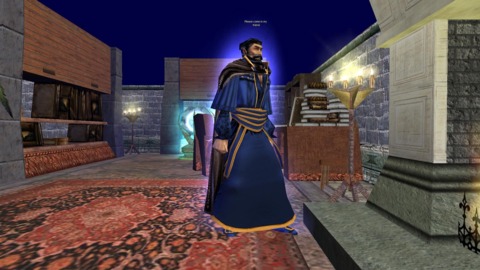
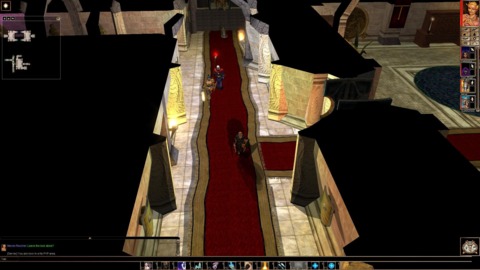
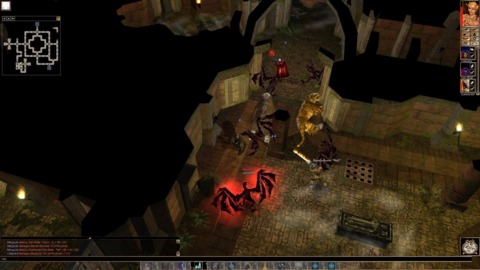
Sure enough, my first rest after inviting Insal into my inner circle resulted in a lighter backpack and a missing thief. Elsewhere, I noted that enemies I encountered remained the same, with clerics attacking me in the temple's living quarters and gelatinous cubes squishing me to death in the lower levels. The module even mirrors the original's resting limitations, much to my chagrin: my full party was devastated by a barrage of blobs because I'd exhausted all of my druid's spells. It was a heartbreaking moment, and I remembered just how difficult the classic Westwood RPG really was. From here on out, I was going to have to cast spells carefully and micromanage my party more stringently, and I asked Francis how he felt the difficulty of his recreation matched the original's.
"We haven't toned anything down. In fact I would have to say that depending on the character class you play as, it can be more difficult at times. We made the mod so it can be played co-op. It's better played co-op with a few friends or family members but there is still a solo mode."
I haven't yet enjoyed cooperative play in my pre-release version of the mod, though I did enjoy how Francis adjusted certain aspects of the original to conform with Neverwinter Nights' mechanics. Eye of the Beholder II requires you to solve multiple puzzles that involve moving objects onto pressure plates, something that the Aurora Engine doesn't allow. In the early hours, it's not much of a problem: you can gain entry just by standing on the plate long enough. Later, however, a puzzle involving moving objects into five different spots was replaced with another, giving me a chance to exercise my brainpower rather than to rely on old memories to get me through.
Such memories can be powerful, and it's his fond recollections of playing the original Eye of the Beholder games that inspired Francis to try his hand at remaking them. "I was stationed in Japan many years ago when [Eye of the Beholder] was released," he says. "I recall spending many late nights playing the game and was completely drawn into it. I've always been a fan of Dungeons & Dragons. I think most people out there love a good RPG. It's quite difficult to find a good D&D game these days that gives you all the role-playing aspects of games like Baldur's Gate or Icewind Dale."
The Neverwinter Nights toolset ended up being the perfect means to Francis' spellcasting end. He says, "When I first started using the toolset, I noticed right away how you placed sections down in blocks very similar to the way the original Eye games were laid out, and this made it very easy to reproduce the original levels. Also since both Neverwinter Nights and Eye of the Beholder are Dungeon & Dragons games with all of the rules, classes, spells, and feats already in place, Eye of the Beholder was a natural candidate for testing the toolset. At the time, I was also looking at the Dungeon Siege tools. I messed around with them, but it just didn't have that right feel to it."
"I vowed to myself to never get involved with another complex and time-consuming mod like this again."
The tools may have made it easy for Francis to lay out dungeons, but scripting was another matter. At first, just figuring out how to make a lever open a door was baffling, and it soon became clear that making his dream module wasn't going to go as smoothly as he initially thought. Luckily, Francis made contact with other Eye of the Beholder enthusiasts eager to assist with the project.
"Our team has grown quite large over the course of the project and spans the globe," Francis tells me. "Geoff is from Australia. Jenny Persson is from Italy and Jörn Preine is from Germany.They both worked on tilesets. Rolo Kip created the crystal wall and Daniel Stierheim wrote the background stories. Both are from the United States, along with beta testers Michael Sinclair and Tim Garret. Other beta testers who worked endlessly include Nigel Traves from the United Kingdom and Adrian Ciuleanu from Romania. All of these people are fans of Dungeons & Dragons and the Eye of the Beholder series. Each of them has contributed in many ways and I can't thank them enough for all of their help."
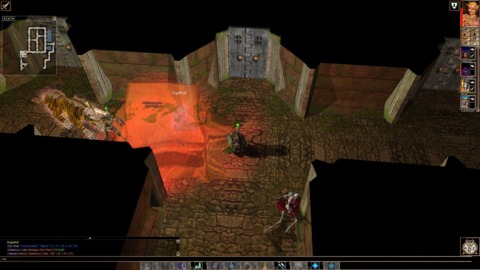
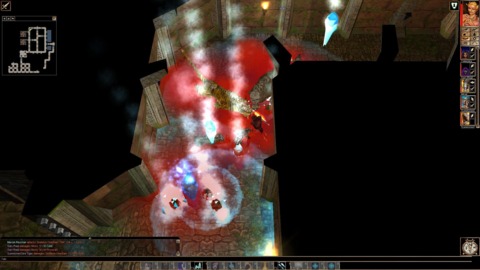
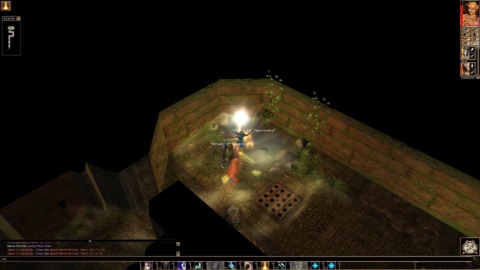
Francis adds: "We have been working on this mod for a better part of 19 months. I started it with a friend of mine who a quarter of the way through decided to discontinue working on the project and left it to me to complete. I almost didn't finish the mod myself, and took some time off in the spring of 2011, after creating the first Eye of the Beholder mod, which took around 2 years. I vowed to myself to never get involved with another complex and time-consuming mod like this again."
An outcry from the Neverwinter Nights community convinced Francis that he should finish the mod. As for me, I am very happy that he's almost done. There's an elegance to Eye of the Beholder II: The Legend of Darkmoon that translates well into a Neverwinter Nights adventure. NWN has aged, but interface and pathing oddities aside, it holds up well: spells create a lovely spectacle, and the game's musical score gives the module's creepy temple a haunting atmosphere. Collecting keys and hunting for hidden levers is an age-old game mechanic, and Eye of the Beholder II is a relic, yet somehow, Rick Francis and his fellow modders have used an aging toolset to make what's old seem practically new again. And that's no mean feat.
'Got a news tip or want to contact us directly? Email news@gamespot.com


Join the conversation